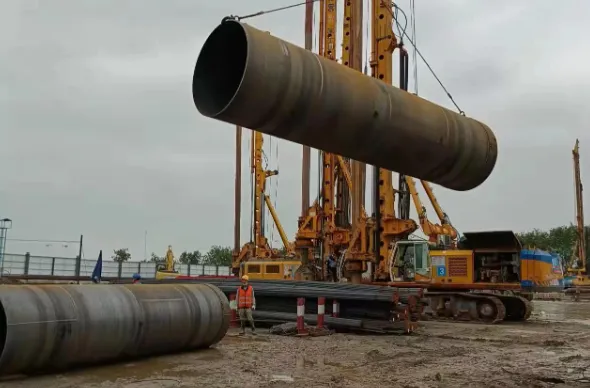What Is Steel Pipe Pile?
Steel pipe piles are an essential component in modern foundation engineering. They are mainly used to transfer structural loads deep into stable soil or rock layers. With their excellent strength and versatility, steel pipe piles play a vital role in construction, marine engineering, and large-scale infrastructure projects.
Types of Steel Pipe Piles
Today, there are three primary types of steel piles commonly used in construction projects: steel pipe piles, profile steel piles, and steel sheet piles. Each type has its specific advantages and best-use scenarios depending on engineering needs.
1. Steel Pipe Piles
Steel pipe piles are widely recognized for their outstanding performance in various construction fields. Compared to other steel piles, steel pipe piles offer several distinct advantages:
High Bending Stiffness: Their circular cross-section provides excellent resistance to bending forces, making them ideal for structures exposed to strong lateral loads.
Superior Single Pile Bearing Capacity: Steel pipe piles can support larger vertical loads individually compared to other pile types, reducing the number of piles needed for a project.
Adaptability: They are suitable for a wide range of soil conditions, from soft clay to dense sand or rock.
These features make steel pipe piles particularly effective for high-rise buildings, bridges, docks, and offshore structures where both strength and durability are critical.
2. Profile Steel Piles
Profile steel piles mainly include I-shaped and H-shaped cross-sections. These piles are highly versatile and are often used where both horizontal and vertical load-bearing capabilities are required.
I-shaped Steel Piles: These are suitable for resisting horizontal forces, especially in retaining wall systems.
H-shaped Steel Piles: With their symmetric shape, H-piles offer balanced resistance against both vertical loads and bending moments.
Profile steel piles are commonly used in bridge foundations, retaining walls, and marine projects where strength and load distribution are essential.
3.Round steel pipe piles
Round steel pipe piles, including
ERW pipe(Electric Resistance Welded),
LSAW pipe (Longitudinal Submerged Arc Welded), and
SSAW pipe(Spiral Submerged Arc Welded), are commonly used in foundation construction for their strength and durability. ERW steel pipe piles are cost-effective and suitable for standard applications. LSAW steel pipe piles provide high strength and are ideal for large infrastructure projects. SSAW steel pipe piles offer excellent resistance to axial and lateral forces, making them ideal for challenging soil conditions. The choice of pile depends on factors like soil type and project requirements.
4. Steel Sheet Piles
Steel sheet piles are designed with interlocking edges, allowing multiple sheets to connect and form continuous walls. They are widely used for:
Coastal and Riverbank Protection: Forming pile walls to prevent erosion or water intrusion.
Temporary Support Structures: Offering sidewall protection when excavating foundation pits or constructing underground facilities.
Survey and Enclosure Systems: Creating sealed environments for dewatering or contaminated site containment.
1. Bearing Piles
Bearing piles are designed to carry heavy loads.Multiple steel pipe piles are driven deep into the ground. The structural load is evenly distributed across all piles.This method ensures maximum stability and reduces settlement issues over time.
2. Bridge Piles
Bridge piles create a strong foundation for bridge structures.Steel pipes are installed by vibrating or hammering them deep into the soil.The required depth and number of piles are pre-calculated according to structural load, terrain conditions, water levels, and bedrock properties.After installation, the steel pipes are often filled with concrete to enhance strength.
3. Construction and Foundation Piles
These piles provide the foundation support for buildings and other structures.They are driven or vibrated into the ground until reaching a firm layer, such as bedrock.Frequently, the hollow pipes are filled with concrete to create a rigid composite pile that resists movement and settlement.
4. Marine and Dock Piles
Marine environments demand strong, durable support systems.Steel pipe piles are driven underwater to form bases for piers, docks, and offshore structures.Both new and recycled steel pipes can be used, depending on the project's specifications and budget.Their corrosion resistance is crucial for long-term performance in saltwater and freshwater environments.
5. Micro Piles, Screw Piles, and Anchor Piles
Micro piles are small-diameter piles used to stabilize damaged or weak structures.They are essential for repairs following subsidence, floods, or seismic events.Anchor piles, resembling giant corkscrews, are screwed into the soil.Once secured, jacking systems are installed to provide maximum support to the repaired structure.These piles are also used to stabilize steep slopes and prevent landslides.
6. Trestles, False Works, and Temporary Structures
Temporary structures made from steel pipe piles are often used during construction projects.They serve as support platforms for workers, materials, and equipment, especially during bridge repairs or building new spans.These temporary trestles ensure safety and efficiency, minimizing disruption to nearby structures or ongoing operations.
Choosing the Right Steel Pipe Pile
When selecting steel pipe piles, consider the following factors:
|
Factor
|
Description
|
|
Soil Type
|
Clay, sand, rock, or mixed soils
|
|
Load Requirements
|
Weight and distribution of the structure
|
|
Water Conditions
|
Groundwater level, tides, or marine environment
|
|
Corrosion Resistance
|
Coatings and material selection
|
|
Pile Size
|
Diameter, thickness, and length based on design
|

Advantages of Using Steel Pipe Piles
Steel pipe piles offer a unique combination of benefits that make them the preferred choice for many projects:
High Load Capacity: Suitable for extremely heavy structures.
Flexible Design Options: Customizable in diameter, thickness, and length.
Easy Installation: Compatible with various driving techniques, including hammering, vibro-driving, and boring.
Durability: Excellent resistance to corrosion with appropriate coatings.
Cost Efficiency: Reduces the need for excess piles and speeds up construction.
Steel pipe piles not only provide strength and flexibility but also enhance the overall economic viability of large-scale projects.






 English
English Español
Español بالعربية
بالعربية











 Phone :
Phone :  Whatsapp :
Whatsapp :  Email :
Email : 


